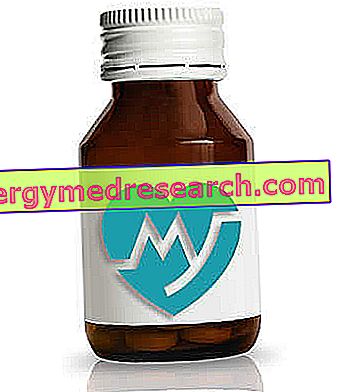
Prevention
Given the lack of effective therapy, the prevention of stretch marks, which should begin as early as possible, is the best remedy.
To avoid or delay the appearance of stretch marks, it is advisable to:
- A diet low in saturated fats and rich in vegetables, whole grains, yogurt and legumes containing vitamins, mineral salts and proteins - which stimulate cell renewal and skin elasticity - can help to avoid overweight and tone the skin, consequently to reduce the risk of stretch marks. The body also needs essential fatty acids found in oily fish (sardines, mackerel, anchovies) and in extra virgin olive oil, which give tone to the skin. Finally, among the fruit, we must not overlook citrus fruits and kiwis, precious sources of vitamin C, capable of preventing cell oxidation and collagen degeneration.
- Do not put on weight, but also avoid drastic weight loss: the recovery of weight that often follows too rapid weight loss produces a deleterious "accordion" effect for the skin;
- Drinking plenty of water (at least 1.5 liters a day) helps keep it hydrated and supple. Take care to always maintain optimal hydration of the skin by applying creams with a moisturizing and emollient action.
- Practice sport as a daily workout.
- Avoid wearing clothes that hinder the outflow of the venous-lymphatic circulation of the lower limbs.
- Not smoking.
Cosmetics against stretch marks
Currently, the treatment of stretch marks aims to attenuate them and improve their appearance, but there are still no effective methods for the complete removal of these annoying imperfections.

As mentioned, therefore, adequate preventive action is essential, especially during puberty and pregnancy, but also in the case of long-term cortisone therapies, both systemic and topical.
The cosmetological treatment, however, can also give discreet results on stretch marks in the forming phase and in the newly formed ones, which can become less visible both in terms of color and size. Better results will be obtained by helping the treatment with healthy life habits and by combining physical exercise with massages, to tone the tissues and improve the efficiency of the vascular-lymphatic microcirculation.
In general, to formulate a product against stretch marks, the anti-aging product strategy is followed but taking into consideration the different area of application. Therefore, at light formulations, very rich emulsions are preferred and suitable for massage. Furthermore, dermo-cosmetic formulations are enriched with moisturizing substances, on the one hand to promote the spread of active ingredients and, on the other, to improve the mechanical characteristics and appearance of the skin in an immediate and perceptible way.
The objectives of cosmetic treatment, in addition to increasing elasticity and hydration are essentially the following:
- Stimulation of fibroblasts (responsible for the production of elastic and collagen fibers)
- Microcirculation stimulation (to promote tissue regeneration)
In the case of recent stretch marks, recognizable by their red-violet color, the daily application of specific cosmetics can help prevent the formation of new ones and make existing ones less visible.
As mentioned, during the "inflammatory phase" of formation of striae distensae, the blocking of fibroblast function and the chemical-physical modification of the fundamental substance takes place (less mucopolysaccharides and decreased activity of glycolytic enzymes), with consequent alteration of the elastic fibers and collagen.
Active Anti-Stretch Mark Principles
One of the treatments used by modern cosmetology consists therefore in the attempt to "stimulate" the dermis, reactivating the fibroblasts and favoring a reparative process with reorganization of the fibers. Among the ingredients used to perform this function we find some vitamins, extracts and vegetable oils, in particular their unsaponifiable fraction.
Vitamin A
Among the vitamins, A, particularly abundant in foods of animal origin such as liver, eggs and milk, plays an important role in the metabolism of the dermis and epidermis. The action of vitamin A or tretinoin on the stimulus of fibroblasts and on skin repair has long been known and reliable clinical studies exist, with mainly positive results. A study comparing the use of 20% glycolic acid and 0.05% tretinoin with that of 20% glycolic acid and L-ascorbic acid showed that both approaches improved the appearance of striae albae 1. In a recent study, tretinoin has been shown to improve the visual appearance of striae distensae during the initial phase (striae rubrae) but not in the cicatricial phase (striae albae) 2. Rangel and others conducted a multicenter study in Mexico on 20 women with post-stretch marks pregnancy-related. After having applied a 0.1% tretinoin cream daily in the abdominal area for 3 months, all lesions have been reduced in length by up to 20% 3 .
1 Ash K, Lord J, Zukowski M, McDaniel DH. Comparison of topical therapy for striae alba (20% glycolic acid / 0.05% tretinoin versus 20% glycolic acid / 10% L-ascorbic acid). Dermatol Surg 1998; 24: 849-56
2 Kang S, Kim KJ, Griffith CE, et al . Topical tretinoin (retinoic acid) improves early stretch marks. Arch Dermatol 1996; 132: 519–26
3 Rangel O, Arias L, Garcia E, et al . Topical tretinoin 0.1% for pregnancy-related abdominal striae: an open-label, multicenter, prospective study . Adv Ther 2001; 18: 181–6



